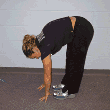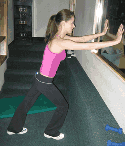In the general public there is much confusion about stretching. Common questions I hear are, is it necessary, am I too old, which muscles need to be stretched, how long do I stretch for, is dynamic stretching better than static stretching? In the professional world of physical fitness and athletics there is no such confusion. Stretching is necessary and should be an integral component of everyone’s exercise routine.
The benefits of stretching are far reaching and vitally important for men and ladies 50+ . The most important benefit is injury prevention. Gentle dynamic stretching in needed before you begin exercising to make sure your muscles are warmed up and loose and gentle static stretching after exercise is necessary to prevent soft tissue contracture and stiffness. Another important benefit of stretching is that it allows you to mentally prepare to exercise. This is especially important if you have had a busy day at work and had to rush to the gym, field or arena to exercise. Stretching allows you a few moments to regroup and refocus on your upcoming exercise routine, run, bike ride, walk or game. This way you are not only physically prepared but mentally prepared as well. After you exercise stretching allows you a few moments to relax and reflect on your exercise or game. It gives you an opportunity to cool down gently rather than abruptly.
There are many different approaches to effective stretching but to fully understand them it is important to consider what we are trying to stretch. It is the soft-tissues of the body that are targeted when we stretch. This includes the muscles, tendons, ligaments and fascia that hold the joints together.
Table 1: Description of the body’s soft-tissues that surround the Joints
|
Tissue |
Description |
| Muscles | Contractile tissue that moves and position the bones by their ability to lengthen and shorten. |
| Connective Tissue: | Non-contractile, tough, fibrous tissue. It may or may not be flexible depending on its function and its ratio of elastic to non-elastic fibres. |
|
Ligaments |
Connective tissue that is comprised primarily of non-elastic fibres and therefore have a limited ability to stretch before tearing. They join bone to bone. |
|
Tendons |
Connective tissue that is comprised primarily of non-elastic fibres and therefore have a limited ability to stretch before tearing. They join muscle to bone. |
|
Fascia |
Connective tissue that is quite flexible due to its large amount of elastic fibres. It holds all the layers of the body together and therefore is present extensively throughout the body. |
When you stretch, it is important to consider all of these different types of soft tissue because each has different needs and requirements. Muscle fibres needs to be stretched slowly and gently. You need to “relax” into the stretch regardless if you are performing a dynamic or static type stretch. If you push a muscle too aggressively into a stretch the muscle will initiate the “stretch reflex” and contract to guard itself against tearing. It is OK to feel some resistance and even a very mild discomfort but never pain. It is also important to breathe normally when you are stretching. A good cue is to visualize the muscle you are stretching actually lengthening. For effective muscle lengthening you need to perform the stretch from 20 to 40 sec.
Ligaments and tendons function to help stabilize the joints that they cross. It is important not to stretch these structures past their normal limits and create a hyper mobile joint. This would leave the joint very vulnerable to injury. If these tissues are lacking their normal flexibility due to injury or disuse, you must stretch them very specifically, carefully and this is best done under the supervision of your personal trainer.
Fascia is deeply entwined in the muscle structure at every level and requires you to hold a stretch for 90-120 seconds to be effective in changing its length. Because of the length of the hold of this stretch, it is important that it is performed very gently. If the stretch is painful you will not be able to hold the stretch the necessary length of time or want to practise the stretch on a regular basis.
The real secret to improving your flexibility is to repeat or practise stretching on a regular basis. Performing a stretching routine once a week for 30 minutes is not as effective as performing the same stretches 6 times a week for 5 minutes at a time. It is important to get into the habit of stretching dynamically before you engage in exercise and perform static stretches after you exercise.
World class athletes recognize the importance of good flexibility to enhance their athletic performance and prevent injury. They have taken the time to learn how to stretch properly. The great thing about stretching is that anyone can do it. The same stretches that a world class athlete does you can do. It does not take great physical conditioning or athlete prowess to stretch. All it takes is a bit if understanding of how to do it properly and discipline to do it regularly.
If you take the time to learn how to stretch and take the time to stretch, you will enjoy exercising much more. You will even find activities of daily living such as bending over, getting out of chairs, reaching behind to put your coat on, lifting your arms above your shoulders and reaching over your head easier to do and this means being more independent and enhancing your quality of living.
Listen to music or watch your favourite TV show while you stretch. Make it fun. Follow the stretches illustrated and explained in Table 2 and begin to stretch regularly today and you will never regret the time you spend doing it.
Table 2: Basic Stretching Routine to get you Started
If you’d like more info please contact Mike.












